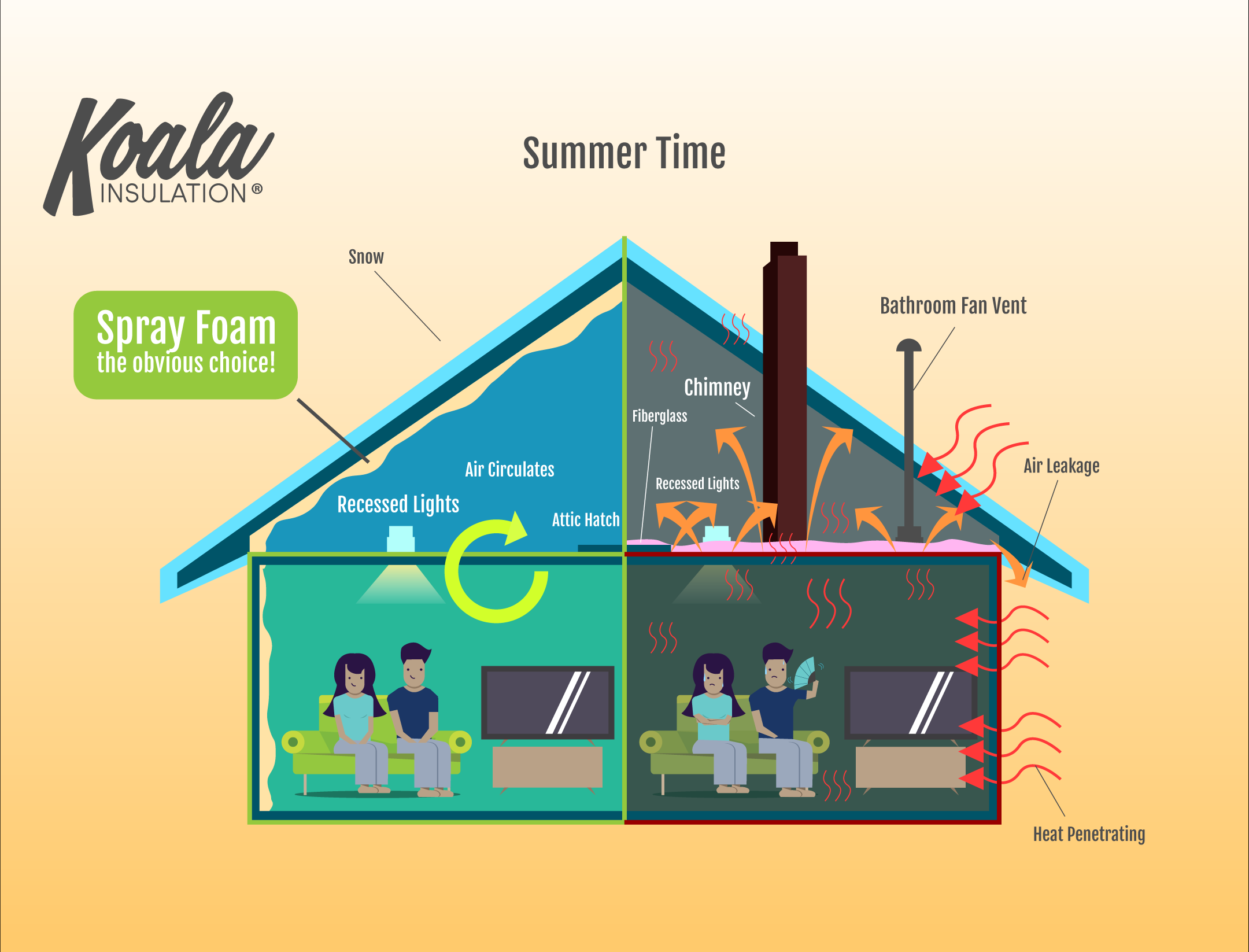How Home Insulation Works in the Summer

Insulation forms a thermal barrier that limits the movement of thermal energy around the house. It prevents the heat from coming into the home during summer and keeps the heat within the house during winter.
In the summer, heat from the sun radiates into your home, heating up the roof and walls. Attic temperatures can go up to nearly 170 degrees, making the home environment uncomfortable.
Despite running throughout, most air conditioning systems fail to lower the temperature below 80 degrees. This is one sign that your home is not adequately insulated, as the heat is coming at the same speed as the cool air from the air conditioning system.
To resolve this challenge, you need to minimize the heat load and stop the heat from entering your home. Insulation installation in the walls and attic is very effective in reducing the heat coming in.
As a result of having a warm home in the winter and a cool house in summer, your energy consumption and expenses reduce.
How Does Insulation Work?
Bulk insulation like fiberglass, and exterior wall insulation function by holding small air bubbles within the material. The idea is to prevent transferring heat across the insulation materials forming the barrier. Since the air is unable to move around, the air pockets have good insulation properties.
Foil insulation also provides insulation but using a different mechanism. The foil has a reflective surface, which serves to deflect the heat back to the source. It’s ideally useful for spaces outside the home, such as the loft or rooftop, or in combination with bulk insulation.
How to Maximize Insulation Effects in Hot Weather
With all the major areas in your home properly insulated, you may not need an air conditioning unit. Some additional tips for keeping your home cool in the summer include:
- Preventing Solar Gain
During sunny days, the sun heats windows and surrounding areas. To reduce the sun’s impact in your home, use drapes, blinds, and have materials with reflective qualities on your windows.
Select materials with pale colors as they will deflect the heat and light instead of absorbing them.
- Enhancing Air Circulation
Since the air is cooler at night, keep your windows open to allow cool air to enter your home. When the sun is up, close all the windows to keep cool air from getting out. Even when using an air conditioning unit, it’s advisable to keep up this practice. To help with air circulation, you can use fans.
Running electronic gadgets also raises the room’s temperature. Switch off the unimportant ones, and keep a dish with cold water or ice under the fan to cools the air inside the room.
Different Types of Insulation
- Roof Insulation
Roof insulation helps to maintain a cool atmosphere in your home regardless of the season. There are some instances where insulating the roof is more effective than insulating the attic. For example, if the air conditioning unit is in the attic or if your attic serves your storage purposes.
- Attic Insulation
If your attic is not insulated correctly, it’s easy for heat to pass through, resulting in higher energy consumption. When the air gets heated, it rises and escapes through the gaps in the attic. To seal these small spaces, the solution is installing attic insulation.
You can use materials such as spray foam, rigid foam, fiberglass, cellulose, or mineral wool. If you opt for fiberglass, you can choose blanket or batt insulation. It has R-values ranging from R-2.9 to R-3.8 for every inch.
Spray foam insulation has an R-value of between R-3.7 and R-6.2 for every inch, while dense cellulose has R-3.8. Rigid foam has R-values ranging from R-4 to R-6.5 per inch, making it one of the most effective materials in reducing energy consumption.
- Crawl Space Insulation
Some builders choose to skip insulating crawl spaces or fail to use the right type of insulation. Besides the discomfort, improper insulation creates a damp environment that encourages mold to grow and wooden components to rot.
The best type of insulation for crawl spaces is rigid foam. It forms a moisture barrier that eliminates molds and stops any moisture from getting absorbed. Another bonus advantage of insulating crawl spaces is that it prevents rodents and pests from entering your home.
Without a proper air seal in the crawl spaces, damp air finds its way into your home, ruining the air quality with time.
- Ceiling Insulation
As the energy costs keep rising by the day, the weather is becoming more extreme. It’s vital to ensure that your home is well insulated to keep the expenses minimal.
Adding or enhancing insulation in the ceiling insulation is one of the most effective ways. In addition to temperature control, ceiling insulation also has soundproofing properties from one floor to the other.
- Wall and Floor Insulation
Insulating the floor and wall spaces in your home helps keep the temperature within your home at a comfortable level. In most regions, the weather calls for insulation all-round the house, including the basement walls, ceiling, roof, and under the floor.
- Duct Insulation
Insulating and sealing ductwork in your home helps to control the temperature and minimize energy consumption. In most cases, uninsulated ducts are in the basement, attic, or crawl spaces.
For extensive projects such as insulation removal, or insulating exterior walls, it’s advisable to do so during summer or spring. The weather is friendly, and the insulation can penetrate your home. It also allows time for blown-in insulation materials to dry well and allows any moisture within the construction materials to evaporate.
When insulating the interior of your home or loft, weather conditions have little effect.
Sources:
www.bobvila.com/articles/types-of-insulation
www.everguardinsulation.com/how-insulation-works
www.beconstructiveltd.com/does-insulation-work-in-summer
www.snappyservices.com/blog/5-faqs-learn-home-insulation-works-summer
Find Your Location


Get a quote


